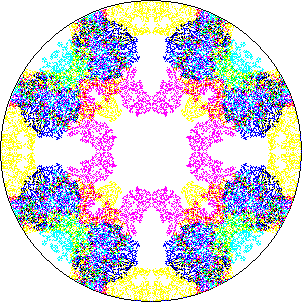
Introduction to Mandala
Greg Ordy, Version 4.0
In 1980, I was attending graduate school at Case Western Reserve University, in Cleveland, Ohio (USA). In the Computer Engineering and Science department, we began to have available graphics devices with individually addressable screen pixels. Prior to that time, common CRT displays were almost exclusively based upon character cells, usually the classic 80 by 24 ASCII display.
There are many ways to evaluate a graphics system. A very simple performance measurement is the number of pixels that can be drawn per second. My good friend and fellow graduate student, Mark Boenke, suggested testing pixel drawing speed while drawing pictures that he called Mandalas. Over the years, whenever I would encounter a new graphics environment, I would always create a Mandala program as a simple test of graphics performance. This version, for Windows, is slightly more polished, but the underlying concepts remain the same. Pixel drawing performance information is contained on the status bar.
One definition of Mandala is a Hindu or Buddhist graphic symbol of the universe. This definition explains much of the interest in Mandalas. For us, another more interesting definition of Mandala is a graphic and often symbolic pattern usually in the form of a circle divided into four separate sections or bearing a multiple projection of an image. These definitions are taken from the Merriam-Webster's on-line Collegiate Dictionary.
In this program, the Mandala is created by drawing one or more snakes which are projected into one or more pie-shaped segments of a circle. A snake has a length and a color. The color is part of a palette. Mandala has a number of predefined palettes, as well as a custom palette, where you can select snake colors and the background color. Mandala provides a set of symmetries that determine how the snakes are projected into segments.
The Mandala created by this program is dynamic, it is always changing. It is animated. The movements of each snake are random. You can vary the drawing speed of the Mandala. As you watch the Mandala, it will take on a number of different configurations. Even though the snake movements are random, the overall visual effect appears to be coordinated or planned due to the symmetry.
Here is a picture of a typical Mandala. To be precise, it is a single iteration of a 4 snake Mandala, where each snake is 8,000 pixels long. The Classic color palette is used. It has 8-way symmetry.

Mandala drawing options and parameters are controlled from a dialog box available through the View|Options menu. Perhaps the best way to learn about Mandala is to simply experiment with the controls on the dialog and watch what is drawn as a result.
Further information on this program, including downloads, can be found on my Mandala web page. This includes links to other sites devoted to Mandala.
Last update: Monday, July 30, 2001 03:17:33 PM
Back to the Mandala Home Page